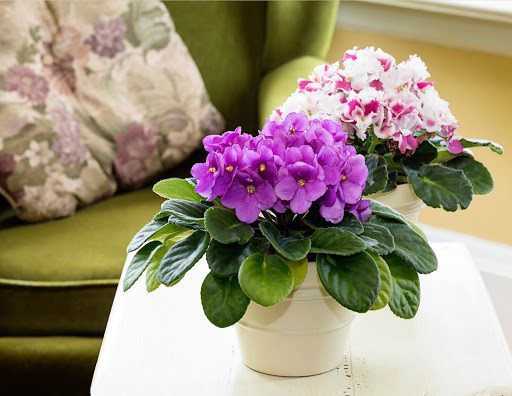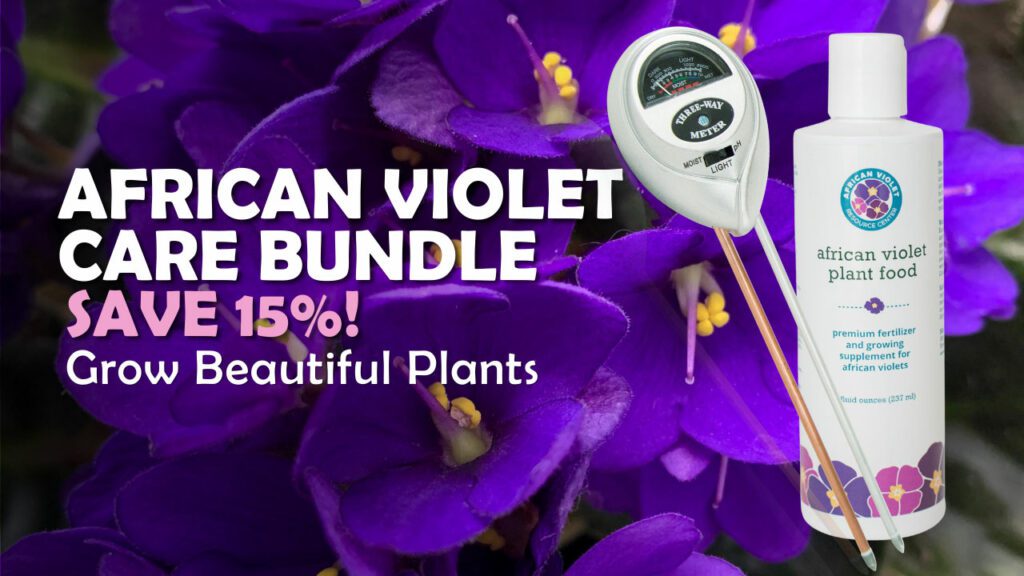Learn 7 key tips to nurture your African violet garden and keep it blooming year-round.
Now that you have one African violet plant, you might be thinking about growing your collection. It’s common for plant lovers to have a few African violets at a time since African violets are truly stunning little plants that offer up their beauty year-round.
If you’re head over heels for your African violet plant, then you’re in the right place. While African violets aren’t particularly hard to care for, we’re here to share a few tried-and-true tips and tricks to keep your plant happy and healthy.
Whether you’re growing one African violet or a handful of them, you’ll want to keep a few simple things in mind as you dial in your care routine. Below, we cover the 7 most important tips for keeping your African violet garden in full-fledged bloom so you can enjoy a roomful of colorful blooms and lush foliage every day.
African Violet Garden Tip #1: Keep your African violet indoors.
While some growers may be tempted to take their plants outside during the summer months, in most cases African violets should be kept indoors year-round. African violet plants are susceptible to insect and heat damage, so they generally do better in controlled environments.
Professional Tip: Natural light and dark cycles encourage blooms. African violets enjoy anywhere between 12-14 hours of light per day and 10-12 hours of darkness per day.
African Violet Garden Tip #2: Keep your plant in indirect light.
African violets prefer indirect sunlight to direct sun. Consistent exposure to strong sunlight can burn your plant’s leaves and damage their blooms. Choose a position that offers bright light, but be sure your plant isn’t in the line of direct sunlight.
Professional Tip: During the summer months, move your African violet to a north- or east-facing window. This will prevent your plant from getting damaged by the strong summer sun’s rays.
African Violet Garden Tip #3: Don’t over-water your plant.
The best advice for African violet watering is to not overdo it. Keep your plant watered but never soaked or sodden.
If you water your plants by hand, try not to splash water onto your African violet’s leaves. The lush green leaves are susceptible to permanent spotting if they’re soaked through with water droplets. Instead, try watering from the bottom.
Professional Tip: If you’re worried about splashing water on your plant’s leaves when you water, you might consider investing in a self-watering pot. This removes the risk of damaging your plant’s leaves and takes the guesswork out of plant watering.
African Violet Garden Tip #4: Buy the right pot.
Choosing a pot for your African violet is an important part of keeping your plant happy and healthy. Most importantly, your pot should have plenty of drainage holes, shouldn’t be too big, and should be a material that you prefer.
While there are many types of pots, some decorative ones come without drainage holes. If you use a pot without any drainage holes, be sure to put the plant in a plastic inset pot first. When it’s time to water, you can remove the plastic pot, give your plant a good drink, and put it back into its decorative home once it’s properly and thoroughly drained.
Professional Tip: For more information on the 3 most important features for your African violet pot, click here.
African Violet Garden Tip #5: Use a humidity tray.
African violets thrive in comfortable indoor temperatures that range from 65 to 75 degrees Fahrenheit, but they do require a humid atmosphere, which is missing from many people’s homes.
To keep your plant happy, use a humidity tray, or use a bottom-up watering system. Your African violet will bask in the moist air as the water evaporates from its dish.
Professional Tip: You can purchase a commercial humidity tray or make your own by placing marbles or pebbles into a dish and setting your plant on top.
African Violet Garden Tip #6: Use a well-draining potting mix.
It’s important to use a well-draining potting mix for your African violet since it’ll protect your plant from root rot. Traditional potting soil is a bit dense for your African violet, so be sure to use a potting mix that’s designed to allow excess water to run through the pot.
Professional Tip: We recommend using a potting mix that’s specially formulated to meet the unique needs of your African violet.
African Violet Garden Tip #7: Use an African violet fertilizer.
If you’re really looking to keep your plant blooming year-round, use an African violet fertilizer to keep it nourished. For many growers, this is the secret to big, healthy blooms.
We recommend using a gentle, liquid fertilizer. Our African Violet Plant Food is made with humic-fulvic acid and sea kelp extract to boost nutrient uptake and encourage hearty roots and vibrant blooms. It’s gentle enough to use every time you water and won’t burn your plant’s delicate root system.
Professional Tip: Use African Violet Plant Food every time you water. It’s safe, easy, and will nourish your plant so you can sit back and watch those blooms explode.
A Recap: 7 Tips to Keep Your African Violet Garden Blooming
There you have it! You’ve learned 7 pro tips to keep your African violet garden in full bloom.
Here’s a recap so you can get started today:
- Keep your African violet indoors so it doesn’t get damaged by outdoor conditions.
- Position your plant in indirect sunlight to avoid burning its leaves and blooms.
- Don’t over-water your plant. This will go a long way to prevent root rot and encourage a healthy plant both above and beneath the soil.
- Use a humidity tray to ensure your plant has a moist environment.
- Buy the right pot to encourage water run-off.
- Use a well-draining potting mix so your plant never sits in soggy soil.
- Use African Violet Plant Food to give your plant the nutrient boost it needs to bloom year-round.
For continued success, explore our other articles, visit our online shop, and connect with other African violet plant lovers in our Facebook group. There, you’ll find everything you need to know to grow your African violet big and strong so you can enjoy it for years to come.







